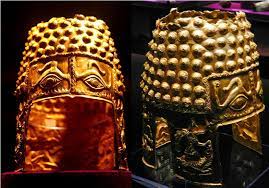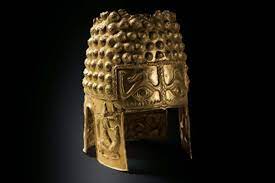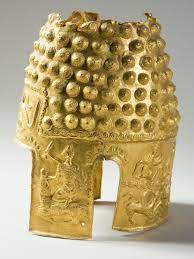The Geto-Dacian ceremonial crown, known as the Golden Helmet/Headdress of Coțofenești, is one of the most extraordinary and significant ancient gold discoveries ever made in Romania. This breathtaking artifact, dating back approximately 2,000 years, offers a fascinating glimpse into the rich cultural and spiritual traditions of the Geto-Dacian people.
Weighing an impressive 726.08 grams and standing 25.50 cm tall with a diameter of 20.00 cm, this magnificent crown is composed of 76% pure gold. Discovered in Prahova County, Romania, this relic showcases the exceptional craftsmanship and artistry of the Geto-Dacian civilization.
In this blog post, we will delve into the captivating history, symbolism, and significance of this remarkable Geto-Dacian ceremonial crown. From its intricate design to its connections with ancient deities and rituals, this treasure trove of information will transport you back in time and shed light on the remarkable legacy of this ancient people.
The Symbolic Imagery of the Geto-Dacian Crown

The Geto-Dacian ceremonial crown is adorned with a wealth of intricate and captivating imagery, each element carrying profound symbolic meaning. At the heart of the crown’s design are winged animals, such as griffins, which were revered by the Geto-Dacians as sacred and powerful creatures.
These winged creatures were believed to be messengers and protectors of the gods, serving as intermediaries between the earthly and divine realms. The inclusion of these winged animals on the crown suggests a deep connection between the Geto-Dacian rulers and the spiritual world, as they sought to align themselves with the divine powers.
In addition to the winged creatures, the crown also features intricate ritual offerings to the Geto-Dacian god, Zamolxis. Zamolxis was a highly revered deity, often associated with the underworld, the afterlife, and the cycles of nature. The presence of these ritual offerings on the crown underscores the profound spiritual and religious significance of this artifact.
The Influence of Mithraism and Celestial Deities

The Geto-Dacian ceremonial crown also displays elements of Mithraic rituals and symbolism, reflecting the diverse cultural influences that shaped the Geto-Dacian civilization. Mithraism, an ancient mystery cult that originated in Persia, had a significant impact on the religious and spiritual practices of the Geto-Dacians.
The crown’s intricate symbolic representations of Mithraic rituals, such as the depiction of the Mithras figure, suggest a deep interconnectedness between the Geto-Dacian and Mithraic belief systems. This integration of Mithraic elements highlights the Geto-Dacians’ openness to incorporating diverse cultural and spiritual influences into their own traditions.
Furthermore, the crown’s connection to celestial deities, such as Apollo and Helios, is particularly intriguing. Scholars believe that the crowns from the Danube Gorge, which featured two eyes, were likely worn by Getae kings who worshipped these solar deities. This association with the sun and its divine powers further emphasizes the Geto-Dacians’ reverence for the heavens and their desire to align themselves with the cosmic forces.
The Ceremonial and Political Significance of the Crown

The Geto-Dacian ceremonial crown held immense significance, not only in the spiritual and religious realms but also in the political and social spheres. The ancient kings and royal families of the Geto-Dacian civilization would wear these crowns during important ceremonies, parades, and even into battle.
The crown served as a powerful symbol of authority, unification, and patriotism. When the king sat on his throne, the crown would have been a visual representation of his power and the strength of the Geto-Dacian kingdom. The gold and silver elements of the crown further reinforced this sense of status and prosperity, with the gold signifying coalition and high standing, while the silver represented the most fertile and prosperous regions.
By wearing the ceremonial crown, the Geto-Dacian rulers were able to project an image of grandeur, strength, and divine connection to their subjects and allies. This display of power and prestige was crucial in maintaining the stability and cohesion of the Geto-Dacian kingdom, as the crown served as a unifying symbol that transcended regional boundaries.
The Geto-Dacians and their Contribution to Ancient European Gold Treasures

The Geto-Dacian civilization was renowned for its exceptional metalworking skills, particularly in the production of gold. In fact, the Geto-Dacians were responsible for operating the largest gold-producing facility in ancient Europe, located at the site of Sarmizegetusa Regia.
This abundance of gold resources, coupled with the Geto-Dacians’ exceptional craftsmanship, allowed them to contribute significantly to the gold treasures found throughout ancient Europe. When examining the gold artifacts and treasures of other ancient civilizations, one can often find similarities and influences that can be traced back to the Geto-Dacian and Thracian cultures.
The Geto-Dacian ceremonial crown is a prime example of this cultural exchange and influence. Its unique design, intricate symbolism, and exceptional craftsmanship have left an indelible mark on the artistic and cultural heritage of the ancient world. By understanding the significance of this crown, we gain a deeper appreciation for the intellectual, spiritual, and philosophical value that the Geto-Dacians placed on their artistic creations.
Conclusion
The Geto-Dacian ceremonial crown, or the Golden Helmet/Headdress of Coțofenești, is a true masterpiece of ancient artistry and a testament to the rich cultural and spiritual traditions of the Geto-Dacian civilization. From its intricate symbolic imagery to its connections with ancient deities and belief systems, this remarkable artifact offers a captivating glimpse into the world of the Geto-Dacians.
As we explore the history and significance of this crown, we are transported back in time, witnessing the grandeur and sophistication of an ancient people who left an indelible mark on the cultural landscape of Europe. The Geto-Dacian ceremonial crown serves as a powerful reminder of the enduring legacy of this remarkable civilization and the enduring human desire to express our deepest beliefs, values, and connections to the divine through the creation of extraordinary works of art.
